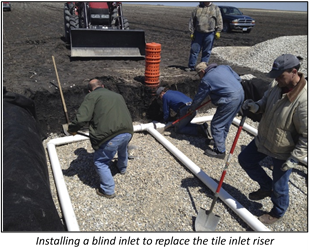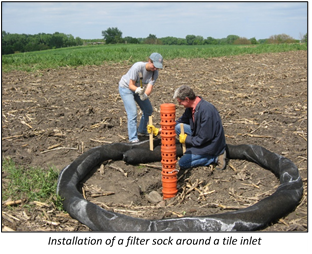| Keep Your Nutrients in Your Field! |

|
Keep Your Nutrients in Your Field!
Approximately 30% of Iowa’s agricultural land is tile drained. Across some Midwestern states, this measure reaches over 50%. When surface water from agricultural fields enters tile inlets, subsurface tile systems act as conveyor belts for water, nutrients, and sediments into our natural waterways. This contributes to a decrease in downstream water quality. A scientist at the National Lab for Agriculture and the Environment, Martin Shipitalo, has been investigating ways to reduce the impact of tile surface inlets on water quality. Specifically, he’s tested three relatively simple and inexpensive practices that mitigate the amount of sediments and nutrients entering the tile system: Grass filters, blind inlets, and woodchip filter socks.
Grass filters are areas of grass planted around the tile inlet, intending to stop sediment from reaching the inlet, also capturing nutrients. Planting grass means crops are not being planted, and it can be challenging to manage grass within a cropped field or during exceptionally wet seasons where excessive ponding could kill the grass. Grass buffers have proven to be effective along riparian zones, but they may not be the best solution within your field.

You may recognize the name ‘French drain’ better than blind inlet, but they are based on the same concept, just different environments. Blind inlets are subsurface structures placed in low lying areas that lessen the amount of sediment and nutrients entering a waterway by filtering water through levels of limestone gravel, geotextile, and a sand-gravel mixture laid over top. The tile inlet is replaced with perforated drain pipes buried between the limestone gravel. A big advantage of this practice is that it is buried and does not take any land out of production.

You have probably seen filter socks at work at construction sites holding back sediment and other materials from flowing into parking lots or roads. Filter socks placed around a tile inlet function in a similar way. In the agricultural case, these socks will be filled with a mixture of woodchips and alum (aluminum sulfate), which increases their retention of dissolved phosphorous. They can also capture sediment from entering and clogging up the inlet. Although relatively easy to install and affordable, the socks will need to be replaced annually to maintain effectiveness.
Each practice has advantages and disadvantages and may appeal to farmers for different reasons. Filter socks are easy to install and are more effective at removing dissolved phosphorous compared to blind inlets. However, blind inlets have performed better at removing sediments and total phosphorous, and generally have a longer life. It is important to provide options to land owners to allow flexible conversations, and more importantly, continual and expanding conservation.
Martin Shipitalo and Gary Baker from E-Tube will be leading a demonstration on blind inlet and filter sock installation June 13, 2018. Visit http://www.southforkwatershed.org/nutrientsworkshop.html for more information and to register.
